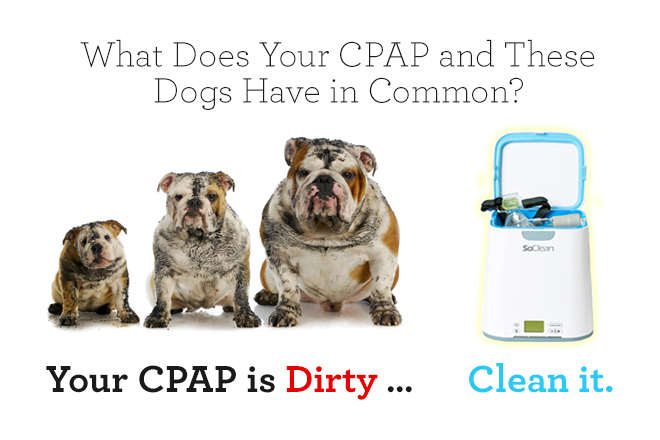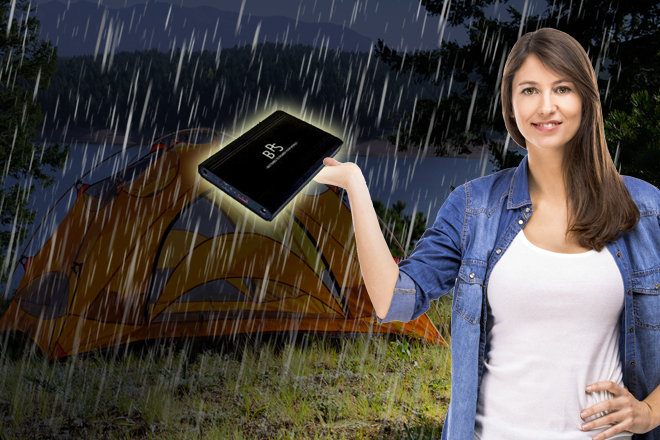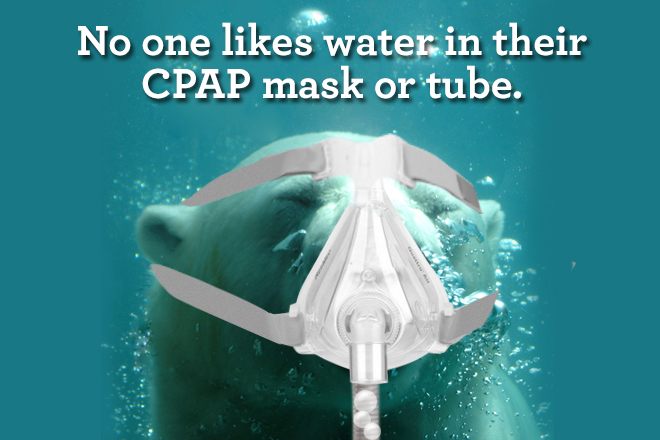Sometimes, starting out CPAP therapy can be a little bit like moving into a new apartment: you love the place and the view, but then you notice that a fuse blows every time you put your dryer on the tumble setting or your ceiling springs a small leak – not to mention the creaking sound coming from the next door neighbors at exactly the same time every night. When it comes to CPAP therapy, there may be a few issues that arise in the beginning of treatment, so it can be helpful to have some pointers to get over that initial hump and to make CPAP therapy more comfortable. Here are five common CPAP issues and five easy solutions.
1. Dirty CPAP Mask
Just look around – your remote, computer keys, anything that you touch or handle on a regular basis is literally teeming with germs and bacteria. If you had telescopic goggles, your home would look like the Calcutta sewage system. So, you can imagine what could be – and probably is – creeping and crawling all over your CPAP mask, hose and machine. This is the reason why you need to clean your CPAP mask on a daily basis – you want to clean the rest of your supplies on a weekly basis. You may also want to try out the SoClean2, which helps removes 99.9% of bacteria, viruses and mold – that is some crazy, super cleaning power. You can imagine how much gross stuff you are leaving behind by not cleaning your CPAP and by not making sanitization a priority. Another option that you should consider is using CPAP Cleaning Wipes – a great alternative that removes dirt, grease and oils from your mask and is fragrance free.
2. Got CPAP Power? – Flying, Camping, Storms, Power Outages, etc.
At the top of the list of things we humans take for granted, like canned cheese and drive through liquor stores, there is one other thing that we take for granted that is way more important: electricity. In fact, there is a good chance that you wouldn’t know what to do if there was a power outage. For sleep apnea sufferers, a black out can be especially troublesome, because even a single night without CPAP therapy may cause you to turn into a zombie. If your neighbors are well armed, the last thing you want to be mistaken for is a zombie. And there are other less dire situations where you may not have an adequate supply of electricity, like during a camping trip. These are a few major reasons why a CPAP battery can come in handy. In fact, the C-100 battery has enough juice to get you through up to five nights without a source of power, which makes it ideal for power outages and outdoor getaways. Another battery to choose from is the ResMed Power Station(RPS), which hooks up to a variety of ResMed machines. We should note that this battery will ding your wallet with a price of nearly $700. The most important thing to remember is that it is critical to have access to your CPAP treatment – power or no power.
3. Wrong Pressure / Not Enough Pressure
CPAP therapy is not supposed to feel like air is being forced down your throat. If it does feel that way, something is wrong. For instance, you could have been prescribed or recommended the wrong pressure settings. This can happen after a sleep lab test offers inadequate results – maybe you slept differently during the test than you normally do, which can throw things off. In fact, a million things can change your need for a different pressure setting: weight fluctuations, sleeping positions, and so on. You can also experience a situation where you aren’t getting enough pressure, which can prevent you from getting the full benefits of CPAP treatment. One of the smartest solutions to this problem is to try out an auto titrating machine, which automatically changes the pressure setting for you. For instance, the S9 AutoSet uses a specialized technology to provide you with just the right pressure setting exactly when you need it. There are a few auto-titrating machines out there from the DS 560 by Philips Respironics to the Icon-Auto by Fisher Paykel but the S9 AutoSet by ResMed has been widely acclaimed as the best auto-titrating CPAP on the market. When it comes to CPAP treatment, if the pressure doesn’t feel quite right, it probably isn’t, so you may want to speak with your physician about a few of your options.
4. Mask Irritation
Just the word alone – irritation – say it three times and you start to feel all itchy and scratchy. When it comes to wearing a CPAP mask, sometimes irritation can occur. This irritation may come in the form of chaffing, redness or just a general sense of unpleasantness. Don’t worry, this is a sign that you are unique and special and that your mask isn’t quite fitting your face as snug as it should be. One solution is to use a CPAP Mask Liner, which provides a comfy cushion between the mask and your skin. Not only will it make your mask more comfortable to wear, but it may also prevent mask leakage, which is probably causing the irritation to happen in the first place. Lastly, if the mask is irritating your shnozz (nose) you should take a look at the Gecko Nasal Pad – a gel type protector for your nose. Last but certainly not least, to help keep your mask clean you should thoroughly clean your face before you go to bed – just so there are no germs or bacteria that could cause the irritation to get worse.
5. Water in Your Mask
If you can think of all the ways that you’d rather not be woken up, getting splashed in your face and up your nose with water is probably at the top of your list. Rainout is one of the most unpleasant side effects of CPAP use and it happens when the room temperature is colder than the humidified air traveling through the tube. Eventually condensation builds up and you get a nice little splash of water in the face. One solution is to place a towel over your CPAP tube to insulate it. Another solution is to raise the temperature of the room. You could also use a specially designed heated tube, like the Hybernite Rainout Control System, which is a stand-alone heated tube that keeps the tube warm using unique heated coils and fits with all flow generators. It’s also worth noting that certain auto-titrating machines such as the S9 AutoSet and the REMstar Auto come equipped with heated tubes. If you are experiencing rainout, you may want to get your hands on a heated tube (no innuendo intended) or explore different options to regulate the temperature in you bedroom.
Lastly, there are only a few common side effects that come along with starting CPAP therapy, but minor as they may be, they can make you uncomfortable enough to put a pause on your treatment, which is never a good idea. Luckily, there are some simple solutions to all of these issues. In fact, even if you are not experiencing these issues now, you may want to think about taking some preventative measures to prevent things like CPAP mask irritation, rainout, being left without treatment during a power outage, not having the right pressure or dealing with supplies that are crawling with bacteria. In the end, life can throw you a curve ball – you can either catch it or let it hit you square in the face.












